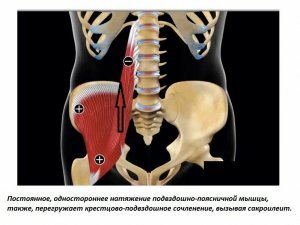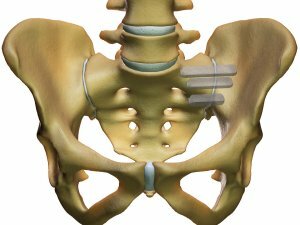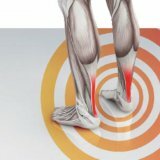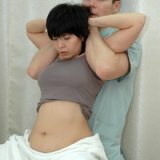Sacroiliitis

Description
Sacroiliitis is an inflammatory disease affecting the sacroiliac joint of the spinal column. It is accompanied by pain in the lower back area. It is an independent disease, a symptom of an autoimmune or infectious disease. It develops more often on the one hand, bilateral sakroileitis is observed with brucellosis and rarely with tuberculosis.
The sacroiliac joint connects the pelvis with the spine with the help of the ear-shaped joints located on the lateral part of the sacrum. It is kept due to strong ligaments located between the sacrum and the ileum. The sacrum is the second lower part( in front of the coccyx) of the spine.
Up to the age of 18, the sacral vertebrae are located separately from each other, and then grow together to form a single bone. In congenital anomalies, fusion is incomplete.
Types of
Sacroiliitis has several types:
- Purulent.
- Infectious-allergic.
- Specific.
Causes of
 The following factors can cause sakroileitis:
The following factors can cause sakroileitis:
- severe physical injury;
- metabolic disorders;
- overstrain of the joint;
- many infections;
- is a developmental disorder of the spine.
Sacroiliitis occurs with autoimmune disease. It flows independently or is a symptom of another disease. Bilateral sakroileitis often occurs with brucellosis, Bekhterev's disease.
Stages of
The disease has 3 stages:
- Symptoms are poorly expressed.
- Appears threading, lumbago. The pain from the buttocks moves to the thigh.
- Periodic cramps, radiculitis, pressure increase.
Symptoms of
 Symptoms of pathology with different types of disease are different. General symptoms include the following:
Symptoms of pathology with different types of disease are different. General symptoms include the following:
- back pain;
- fast fatigue;
- deterioration of visual acuity( rarely);
- limited mobility;
- periodic lumbago;
- arrhythmia and other heart problems;
- subfebrile temperature( a long period holds 38 degrees);
- worsening of peripheral joints.
The main symptom - regular pain, giving back, sacrum, buttocks and thigh area. The pain increases sharply with prolonged walking, slopes.
Diagnostics
The pathology is treated by an orthopedic trauma specialist. He will conduct a visual examination of the patient, test the gait, tone, strength of muscles and the volume of movements of the lower extremities and pelvic joints. Further, extensive research is carried out and, of course, x-rays.
X-ray examination will help to see the compaction of bone tissue, erosion, narrowing or absence of joint space. The diagnosis is made taking into account all the analyzes.
Treatment
 Treatment involves the elimination of a purulent focus, is usually carried out in a hospital. Resection of the joint is performed, drainage of suppurative fouling.
Treatment involves the elimination of a purulent focus, is usually carried out in a hospital. Resection of the joint is performed, drainage of suppurative fouling.
In acute form appoint antibiotics. Enter the drugs intramuscularly.
The chronic form is treated conservatively. Apply antibacterial therapy, fixing the joint with gypsum.
In severe cases, a resection of the sacroiliac joint is performed. Treatment of the aseptic form is aimed only at eliminating the causes of the disease. Physiotherapeutic procedures are prescribed.
Often the disease proceeds in a chronic form with exacerbations, it can be of brucellosis and tuberculosis origin. Brucellosis sacroiliitis is more two-sided.
Folk remedies
It is impossible to treat this serious illness independently. Folk remedies do not eliminate the cause and consequences of the disease. They can only be used in combination with medicines and only with the permission of the doctor.
As a body-supporting remedy is recommended:
- Take mummy solution( 3%) on an empty stomach and at bedtime before 20 ml.
- Chopped eggshells should be taken 2 hours before dinner for ½ grams.
Complications of
A serious complication is the formation of purulent fouling. They can erupt into the buttocks and the pelvic cavity. At palpation elastic formation is felt.
The entry of pus into the canal of the spinal column and the sacral orifice is accompanied by a lesion of the spinal cord, as well as its membranes.
Prevention
To prevent disease, it is required to maintain immunity, to treat infectious diseases in a timely manner. Otherwise, you can get complications on the joints. It is useful to do sports, move more. Do not overload the joints.
The appearance of back pain signals us of danger. It is urgent to take measures - to pay a visit to an orthopedic specialist and carry out all his recommendations further. And the back will always be healthy.



